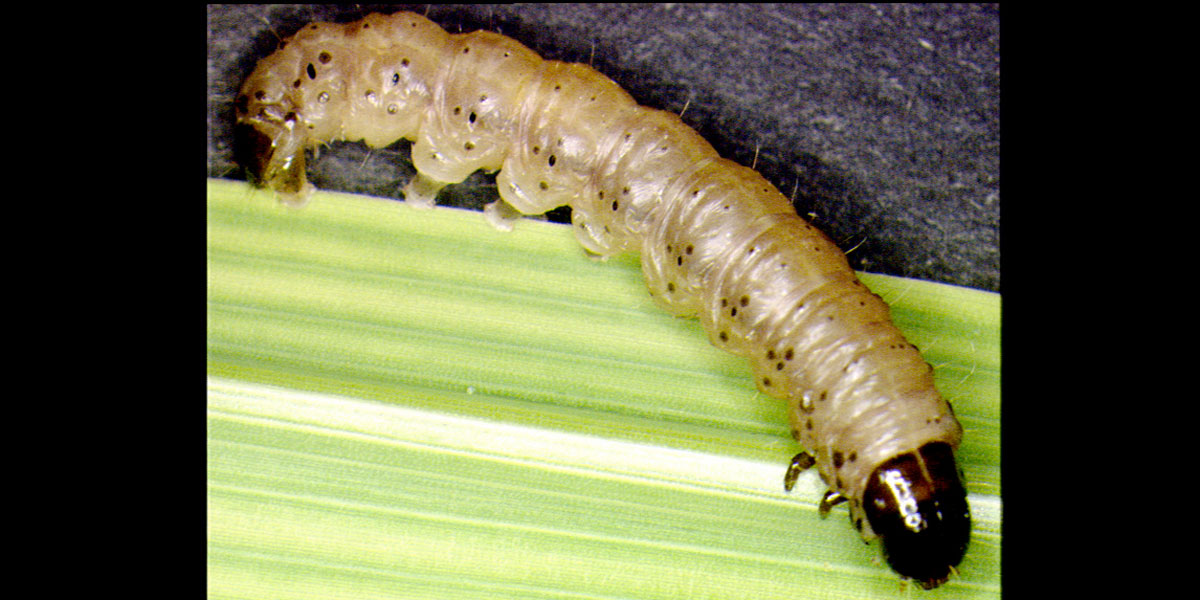
The African maize stalkborer pest is already largely resistant to single-gene Bt maize and is showing first signs of resistance to stacked-trait Bt maize
The study below assesses the evolution of resistance of the African maize stalkborer pest (Busseola fusca) to GM Bt insecticidal maize of single-gene and stacked-gene types.
Regarding the single-gene maize types, the researchers found rapidly evolved resistance: "Pre-release evaluation of the single-gene event showed very low larval survival on Bt maize leaf tissue while studies 10 yr later and the current study reported survival of up to 40% and 100% on Cry1Ab maize, respectively."
The study found that the stacked-gene types of maize were more effective than single-gene types in combatting the pest – but resistance appears to be evolving in the stacked-gene maize types too. The study concludes, "While high levels of resistance of B. fusca populations to Cry1Ab maize were observed in this study, no population showed resistance against the stacked event that expresses Cry1A.105+Cry2Ab2 proteins. However, although no larvae completed their life cycle on the stacked-gene event, the increased numbers of days until 50% mortality was reached are comparatively longer than those reported earlier which could show a shift in susceptibility. This study confirms resistance of B. fusca to Bt maize that expresses Cry1Ab proteins and highlights the importance of continuous monitoring of the resistance status of this pest."
---
Resistance status of Busseola fusca (Lepidoptera: Noctuidae) populations to single- and stacked-gene Bt maize in South Africa
Strydom, E., Erasmus, A., du Plessis, H., & Van den Berg, J. Journal of economic entomology (2018).
https://academic.oup.com/jee/advance-article-abstract/doi/10.1093/jee/toy306/5128789
Abstract
Transgenic Bt maize expressing Cry insecticidal δ-endotoxins of Bacillus thuringiensis has been cultivated in South Africa for the control of Busseola fusca since 1998. Busseola fusca is resistant to Cry1Ab Bt maize at many localities throughout the maize production region. Pre-release evaluation (1994–1996) of the inherent susceptibility and post-release assessments (1998–2011) of resistance status of B. fusca focused on a limited number of pest populations. This study reports the current levels of susceptibility of 10 B. fusca populations evaluated between 2013 and 2017 and compared this data with previously reported data on the survival of this pest on Bt maize, including data of pre-release evaluations done during 1994 and 1995. Larval feeding bioassays in which plant tissue of maize events expressing either Cry1Ab or Cry1A.105+Cry2Ab2 (stacked event) proteins were conducted and survival and different life history parameters recorded. Results show a shift in levels of susceptibility of B. fusca to Bt maize. Pre-release evaluation of the single-gene event showed very low larval survival on Bt maize leaf tissue while studies 10 yr later and the current study reported survival of up to 40% and 100% on Cry1Ab maize, respectively. While no larvae completed their life cycle on the stacked event, higher LT50 values in this study indicate a shift in susceptibility of B. fusca to the stacked-gene event and highlight the importance of baseline information and monitoring of pest populations for their susceptibility to Bt maize.